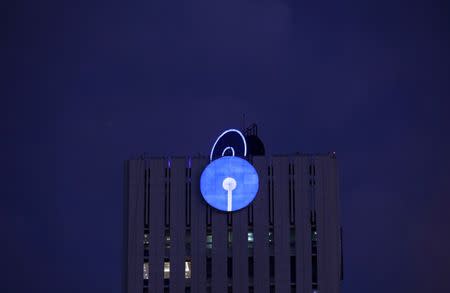State Bank of India sees rebound after record $1.1 billion fourth-quarter loss
By Devidutta Tripathy and Vishal Sridhar
MUMBAI (Reuters) - State Bank of India (SBI) projected a recovery over the next two years after a record 77.18 billion-rupee ($1.13 billion) fourth-quarter net loss following stricter central bank rules around bad loans, sending its shares to a nearly six-week closing high.
"Last year was a year of despair. This year is a year of hope, and next year will be a year of happiness," Chairman Rajnish Kumar, who was named to his position last October, told a news conference at the bank's headquarters after the results.
The lender which accounts for more than a fifth of India's banking assets said it aims to grow loans at an annual average of 12 percent through March 2020, nearly halve its gross non-performing loan ratio, bring down provisioning costs and improve margins.
Kumar is changing the more than 200-year-old bank's lending practices and risk management process by restructuring units to focus on better-rated corporates, and growing retail loans faster to counter a surge in bad loans.
Kumar is also betting loan recoveries from defaulter companies under resolution at India's nascent bankruptcy court will also help the bank cut bad loans starting the current financial year, after the bank set aside about 707 billion rupees for loan losses in the last year to March.
The company's financial year runs from April-March.
During the three months to March 31, SBI added 336.7 billion rupees of additional non-performing loans, taking its total to 2.23 trillion rupees, or 10.91 percent of total loans.
From 10.35 percent at the end of December, that was still a smaller proportional increase for the bank, most of whose peers have seen their soured loans and provisions surge after the central bank in February eliminated half a dozen loan restructuring schemes to hasten the clean-up of near-record levels of soured debt.
Most state-run banks that have reported quarterly earnings so far have posted losses. Second-largest state-run lender Punjab National Bank reported a nearly $2 billion net loss, hurt by a massive fraud.
SBI's March quarter net loss compared with a 12.85 billion rupee loss in average estimates of 16 analysts complied by Thomson Reuters. The results were also hurt by treasury losses due to a spike in bond yields. For the year ago quarter, the bank reported a restated net loss of 34.42 billion rupees.
"The worst is over for SBI," said A.K. Prabhakar, head of research at IDBI Capital in Mumbai, adding that the March quarter results were largely on expected lines and the bad loan additions had been smaller than feared.
Chairman Kumar forecast SBI's gross bad loan ratio to come down to below 6 percent by March 2020 and provisioning costs to fall to 1.1 percent from 3.6 percent as of last March. He also expected the bank's net interest margin and return on asset ratio to improve by March 2020.
SBI shares closed 3.9 percent up, their highest level since April 11, having risen as much as 6.2 percent in the afternoon session after results. ($1 = 68.0350 Indian rupees)
(Reporting by Devidutta Tripathy and Vishal Sridhar; Editing by Christopher Cushing and Keith Weir)

 Yahoo Finance
Yahoo Finance 



